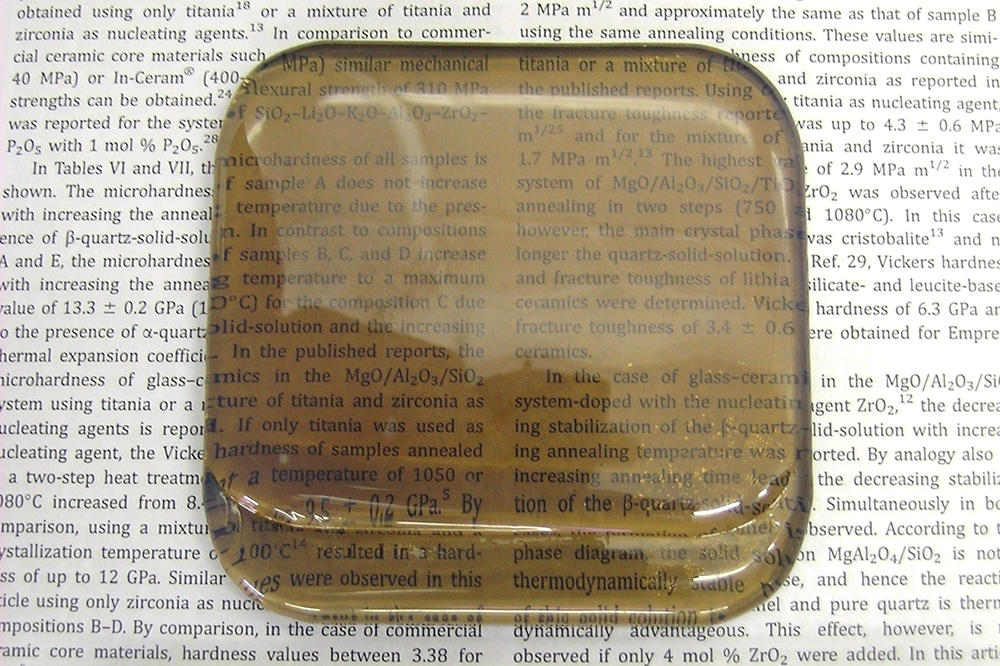

Oxides of magnesium, aluminum and silicon combine transparency, hardness and low density, with ample application potential
Oxides of magnesium, aluminum and silicon combine transparency, hardness and low density, with ample application potential.
Oxides of magnesium, aluminum and silicon combine transparency, hardness and low density, with ample application potential.

Oxides of magnesium, aluminum and silicon combine transparency, hardness and low density, with ample application potential
By José Tadeu Arantes
Agência FAPESP – A very hard, transparent, low-density glass-ceramic material with the potential to replace the ordinary glass used to make screens for tablets and smartphones, as well as the tempered and toughened types of glass used in buildings, automotive vehicle windows and helmet visors, has emerged from a study performed by Leonardo Sant’Ana Gallo, a PhD student in materials science and engineering at the Federal University of São Carlos (UFSCar), São Paulo State, Brazil.
His oral presentation on “Correlations between crystallization, microstructure and mechanical properties of MgO-Al2O3-SiO2 glass-ceramics” won an award as one of the five best poster presentations by researchers aged 40 or younger at the Eleventh International Symposium on Crystallization in Glasses & Liquids, held in October in Nagaoka, Japan. The symposium is one of the most important international scientific meetings on glass and has been held regularly since 1960.
The study reported in the poster presentation was part of Gallo’s research project, “Mechanical properties of glass-ceramics in the CaO-MgO-Al2O3-SiO2 system,” performed at UFSCar under the supervision of Professors Edgar Dutra Zanotto and Ana Candida Martins Rodrigues and at the University of Rennes 1 in France under the supervision of Professor Tanguy Rouxel. Gallo was supported by FAPESP through a scholarship awarded under its Research Internship Abroad Program (BEPE).
“Thanks to its properties – transparency, hardness and low density – this glass-ceramic material has significant application potential,” Gallo told Agência FAPESP. “For example, it can be used to make thinner screens for smartphones, which will weigh less as a result, and lighter bulletproof windows with no loss of effectiveness compared with today’s.”
If a bullet were to hit this material, the material would shatter, but the bullet would not pass through because the material would absorb the energy in the projectile.
Glass-ceramics are produced by partial crystallization of glass. Conventional glass is non-crystalline and amorphous, whereas glass-ceramic materials have crystalline structures distributed in an amorphous matrix. “The crystal phases determine their special characteristics,” Gallo said.
To attain crystallization, an oxide mixture is submitted to two heat treatments, at 700°C and 900°C. “What’s particularly interesting in our case is that we’ve obtained a material that remains transparent after crystallization,” he added. “That’s neither common nor easy to obtain. Materials usually become opaque after crystallization.”
“When the oxide mixture is heated, its molecular structure reorganizes,” explained Prof. Zanotto, who runs the Center for Research, Teaching, and Innovation in Glass (CeRTEV), one of the Research, Innovation and Dissemination Centers (RIDCs) funded by FAPESP. Zanotto supervised Gallo’s PhD research. “Small crystals are formed at sites distributed within the amorphous matrix. In this particular case, they’re composites of magnesium, aluminum and silicon, such as cordierite and sapphirine, among others. Their characteristics are defined by three variables: the chemical composition of the glass, the heat treatment temperatures, and the length of exposure to these temperatures. Each stage of the process can be rigorously controlled, including the percentage of the material to be crystallized to obtain the end-product of interest.”
Gallo is now working on another project for his PhD, “Microstructure and mechanical properties of glass-ceramics from the CaO-MgO-Al2O3-SiO2 system for ballistic protection,” supported by a scholarship from FAPESP linked to CeRTEV. His previous research led to UFSCar’s Innovation Agency’s filing a patent application in 2013, which is now being assessed by INPI, Brazil’s patent office. “We’ll soon be able to look for partners in order to commercialize the product and bring it to market,” he said.
Republish
The Agency FAPESP licenses news via Creative Commons (CC-BY-NC-ND) so that they can be republished free of charge and in a simple way by other digital or printed vehicles. Agência FAPESP must be credited as the source of the content being republished and the name of the reporter (if any) must be attributed. Using the HMTL button below allows compliance with these rules, detailed in Digital Republishing Policy FAPESP.





